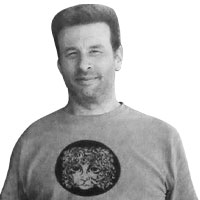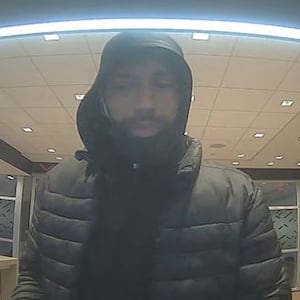Law enforcement identified a suspect accused of gunning down five homeless men in Washington, D.C. and New York City over the past two weeks—killing two—after a tipster called police with the suspect’s phone number and Instagram handle, after which cops reviewed cellphone location data to place him at the scene of additional shootings, according to a probable cause affidavit filed Tuesday in D.C. Superior Court.
Gerald Brevard III, 30, was arrested Tuesday by police in D.C., where three of the five attacks took place. Brevard, whose father told The Daily Beast that his son had been “dealing with mental illness for the longest time,” is charged with first-degree murder, assault with intent to kill, and assault with a dangerous weapon.
Brevard’s arrest capped an intense multistate manhunt with a $70,000 reward for his capture. Cops believe Brevard was also behind two shootings of homeless men in New York City last weekend, in which one person died, but have not yet charged him with a crime. Brevard was unarmed when he was arrested, and investigators have not recovered a weapon. However, ballistics evidence has linked the D.C. and New York City shootings, according to authorities.
ADVERTISEMENT
“We believe that it’s random,” D.C. Police Chief Robert J. Contee III said at a news conference on Tuesday. “I don’t know that he knew these guys.”
The first attack occurred around 4:30 a.m. on March 3, according to the affidavit. The target, who was shot multiple times in the lower back and right shoulder, bandaged up his wounds and waited about 90 minutes before calling the police. After officers arrived, the unidentified victim was taken to an area hospital with non-life-threatening injuries and released.
According to the initial police report, the victim told cops the suspect, whom he described as a Black man in his 30s or 40s wearing a black sweatsuit and armed with a black handgun, ran away after shooting him.
Investigators later found two .22 caliber cartridge casings at the scene, both of which were stamped with the letter “C,” according to the affidavit.
On March 8, shortly before 1:30 a.m., D.C. Metro cops responded to a report of shots fired near a homeless encampment roughly a mile and a half from where the March 3 shooting took place.
When they got there, officers “found the victim… alongside a construction site on the southeast corner of 17th and H Streets suffering from multiple gunshot wounds,” states the affidavit, adding that the target “sustained gunshot wounds to the head, face, chest, thigh, buttock, and hand.” His injuries were so extensive that detectives have not been able to interview him, and the unnamed man remains hospitalized, the filing says.
Again, investigators found several .22 caliber cartridge casings stamped with the letter “C” at the scene. In footage from nearby security cameras, the victim “can be heard yelling ‘no, no, no’ and ‘please don’t shoot’ after a single gunshot was heard,” according to the affidavit. Minutes later, the footage showed Brevard sitting on the curb, playing music on his cellphone, the document reveals.
At 2:54 a.m. the next day, a D.C. cop on patrol came upon a fire burning on New York Avenue in the northeastern part of the city, less than a half-mile from the shooting on March 3 and less than two miles from the one on March 8.
After firefighters extinguished the blaze, first responders discovered the remains of a 54-year-old homeless man, Morgan Holmes. He had been stabbed multiple times and shot at least twice, and was pronounced dead at 3:27 a.m.
As in the first two incidents, police found two .22 caliber cartridge casings stamped with the letter “C,” at the scene. Security video from the area on both dates shows a Black man matching the same physical description and wearing the same clothing as seen on footage captured at the first shooting, according to the affidavit.
In the days that followed, homeless in New York City began getting shot, seemingly at random.
At roughly 4:36 a.m. on March 12, a homeless man sleeping on the street in downtown Manhattan was shot once in the arm by a man described by witnesses, variously, as a Black man and a white or Hispanic man, dressed in black and wearing a black face mask. NYPD investigators found a single .22 caliber cartridge casing, again stamped with a “C,” on the scene, the affidavit states.
That afternoon, police were called to another location in Lower Manhattan, where they found the body of a second as-yet-unidentified homeless man.
“Officers located and recovered five .22 caliber cartridge casings,” the affidavit says. “Each of the casings had the letter ‘C’ on the headstamp.”
Witnesses gave officers a similar description of the suspect as in the previous incidents.
“The distance between the two shootings in New York, N.Y. is less than one mile,” notes the affidavit.
Authorities distributed photos of Brevard, and leads began rolling in.
One tipster “specifically named… Brevard as the person depicted in images publicly released,” the affidavit says. “The tipster… said [they] personally knew… Brevard and that he had a child by a woman [the tipster] knew,” and provided cops with Brevard’s date of birth, telephone number, and Instagram handle.
“In a follow-up interview with [the tipster], detectives learned that [the tipster] had known Brevard for several years and knew him well. [The tipster] stated [they] observed a photo on a news program and recognized that photo as depicting… Brevard.”
After detectives showed the tipster a video still of Brevard at D.C.’s Union Station, the tipster “immediately responded by stating, ‘That's him,’” according to the affidavit.
“Is that Gerald?” investigators asked, wanting to make sure.
“Yes,” the tipster replied.
Police reviewed Brevard’s Instagram page, where they spotted a post showing him in an outfit “consistent with” the one he was wearing on surveillance video captured at the crime scenes. On March 14, Brevard “posted a picture of himself along with the [caption], ‘Feeling Devilish Feeling Godly,’” the affidavit says. “Detectives were able to determine that the photograph was taken in Washington, D.C.”
Investigators subpoenaed Instagram to make sure they had the correct phone number for Brevard, then subpoenaed his cellular provider to get location data for Brevard’s phone.
“[T]hat data indicates that the device utilizing… Brevard’s number appeared to be in Washington, D.C. in the late evening of March 11, in New York City on the morning of March 12, and back in Washington, D.C., on the morning of March 13,” the affidavit states. “The communications in New York City place… Brevard’s device in the area of the two locations around the time of each offense.”
At around 2:30 a.m. on March 15, Brevard was arrested by federal agents at a D.C. gas station. He attempted to flee but didn’t get far, according to the affidavit.
On Wednesday, Brevard’s lawyer argued in court that eyewitnesses offered conflicting descriptions of his client and noted that police have not recovered the gun Brevard allegedly used.
In response, prosecutors pointed to Brevard’s criminal history, which includes assaulting a police officer.
Brevard was booked into the D.C. jail, where he is being held without bail.







